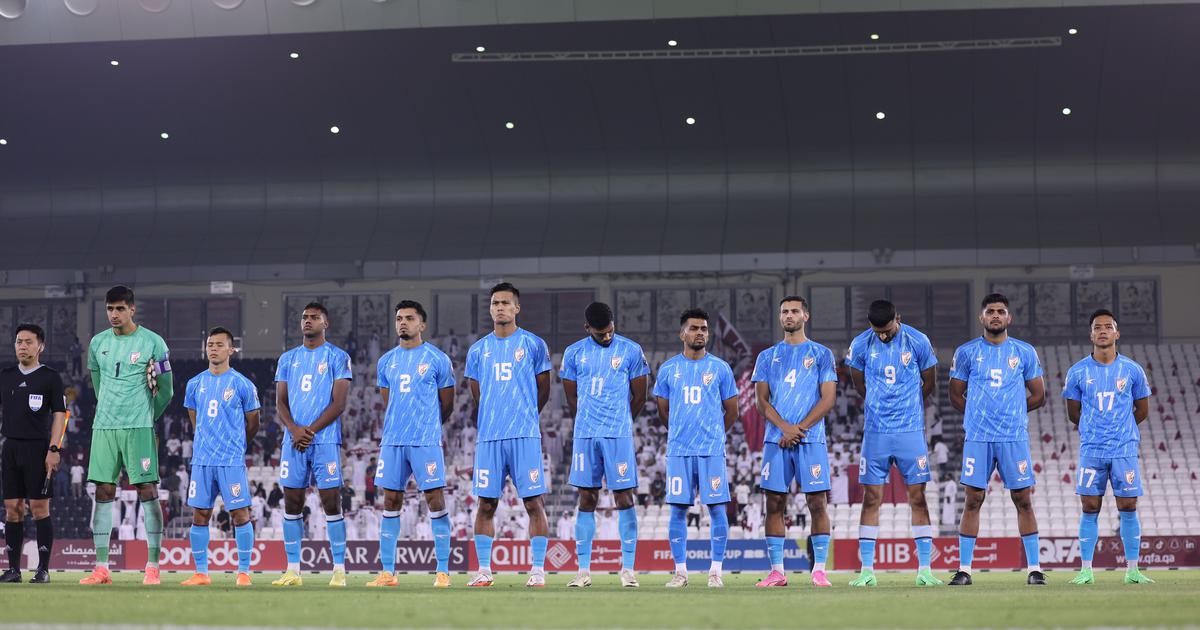You cannot shake the feeling that Indian football was robbed of something truly special following their controversial 1-2 loss to two-time defending AFC Asian Cup champions Qatar on Tuesday.
While it is convenient to blame the match officials for allowing Qatar’s opening goal to stand, it is not the reason why the Indian men’s team once again failed to go through to the third round of the Fifa World Cup Qualifiers.
The controversial loss should not take away from the fact that India have only themselves to blame for not getting the job done. In a group that also featured lower-ranked Kuwait and Afghanistan, India could manage only one win in six matches.
Qualifying for the Fifa World Cup was always going to be a monumental task. However, the expansion of the tournament from 32 teams to 48 teams from the 2026 edition onwards meant that the path had been made slightly easier for underdogs like India.
The expansion saw the Asian Football Confederation’s direct qualification slots double from four to eight. This also meant that the number of teams who made it to the third round of the Asian World Cup qualifiers increased from 12 to 18.
Qualifying for the third round would have proven to be a big step in India’s journey to be a top 20 side in Asia – India has never reached the third round. Not only would it have provided the sport in the country with a boost, it would have also seen India given the opportunity to test themselves against continental powerhouses like Japan, Saudi Arabia and the likes.
It cannot be denied that in Group A of the second round of qualifiers, India were given a favourable draw featuring Qatar, Afghanistan and Kuwait with the latter two well below India in the Fifa rankings. On paper, India should have made it to the third round as the second-placed side behind Qatar. Instead, it’s back to square one for head coach Igor Stimac’s side.
So how do India find themselves preparing to go through the now-familiar churn of playing in the AFC Asian Cup qualifying third round?
After India’s dismal showing at the AFC Asian Cup earlier this year which saw them fail to score a goal and secure a point, Stimac vowed to take his side to the third round of the World Cup Qualifiers.
Given the year India had had, discounting the Asian Cup campaign, confidence in the team was at a high. They had won three titles in 2023 and had held a good Iraqi side to a 2-2 draw.
Before the Asian Cup, India were second in their World Cup qualifying group having secured a 1-0 win away at Kuwait before succumbing to a 0-3 loss to Qatar. But their form since the turn of the year has been shockingly poor.
They were held to a goalless draw by Afghanistan in March before succumbing to a shock 1-2 defeat to the same opposition five days later at home. Last week, Kuwait did an excellent job of killing the game in Sunil Chhetri’s final match for India as they held the home side to another goalless draw in Kolkata.
India lost two of their three home matches, conceded five goals and scored only once, a Sunil Chhetri penalty in the loss to Afghanistan. A horrible form at home for a side looking to rise up the standings in Asia.
The qualification campaign also highlighted India’s dismal form in front of goal. Even with Chhetri, India’s record goalscorer playing in five of the six matches, India laboured to score just three goals. A whopping 28 of the 36 teams in the second round scored more goals than India.
On Tuesday, the Indian front three of Rahim Ali, Manvir Singh and Lallianzuala Chhangte showed promise in front of goal as they created a couple of big chances, which, had they converted, could have seen India leading 3-0 at halftime against a second-string Qatari side.
Instead, despite Chhangte opening the scoring, they ended up losing the game. Even if Qatar’s opening goal was not allowed to stand, a draw would not have been enough for India since Kuwait had more points due to their win over the Afghans.
So what next for India? For starters, the All India Football Federation needs to decide whether to stick with Stimac.
The Croat had a lot of goodwill this time last year after leading India to two titles – the Intercontinental Cup and the SAFF Championship. That has all but evaporated after his side’s poor showing at the Asian Cup.
After the loss to Afghanistan, the Croat had claimed that he would leave the job if India failed to make it to the third round.
Should he decide to go back on his word, it will be up to the Indian football body to take a call on Stimac’s future. That, however, will not be an easy task given that in October 2023, the AIFF extended Stimac’s contract till June 2026.
However, the football governing body reportedly dropped the termination clause from the previous contract. That means that should the AIFF sack Stimac, they will have to pay the Croat his full salary, which is reportedly worth $750,000. Money that the AIFF may not have.
All this points to the haphazard nature of how things are run at the AIFF. Stimac and the team will be held accountable, but the administration is equally responsible for the state the Indian men’s team finds itself in.
One can only hope they will look beyond that controversial Qatari goal, and look at the hard facts that the team has just not been good enough.










